Table Of Content
- Transforming timeless Hmong fabric artwork into lasting Quilts
- Hmong Digital Files - Starter Pack 1. JPEG, PNG. Digital file. Updated 11.11.2023
- Blue Hmong Pattern Washi Tape 10pcs Decorative Tape
- Henna design book: Hmong batik designs
- COMMON SYMBOLS & THEIR MEANINGS
- Dong-Yi People Hmong People: Dong-Yi People Native Americans Ancestors

That changed, she said, when she learned her parents’ refugee stories, and realized how important it was to honor their history through her own art. A common story shared by many elders say that paj ntaub (flower cloth) are the remnants of the Hmong language. Hmong women coded onto clothing their language in order to disguise their stories from their oppressors.
Transforming timeless Hmong fabric artwork into lasting Quilts
We designed this DIY Kit with lots of options for you to choose from. Not only do you have four different styles and sizes of bags but you also have different traditional Hmong patterns with different colors. The Hmong are thought to originate from the plains of Tibet and Mongolia, moving southwards through China. According to Lao records, they started arriving in Laos in the early 19th century.

Hmong Digital Files - Starter Pack 1. JPEG, PNG. Digital file. Updated 11.11.2023
Meanwhile, Hmong people in Southeast Asia and China still embroider in order to make a living from their crafts, but they have learned to adapt due to access of materials, machines, and markets. Hemp is most commonly used for funeral garments in the contemporary era. Hmong motifs are copied, and replicated into machine-made patterns with Hmong designs and motifs. These copied patterns are made into pleated skirts, cuffs, and the placket fronts of jackets, as well as accessories. As the Hmong continue to live in the United States, their lifestyles have changed due to employment and educational opportunities.
Blue Hmong Pattern Washi Tape 10pcs Decorative Tape

In Thailand, story cloths were sold at open markets to Western aid workers or sent to relatives in other countries (USA, France, Australia, etc). Story cloths can invite the viewer to empathize and appreciate the experiences of the Hmong people. The stories revealed the essence of humanity by seeking peace only to face wars, escaping tragedy to find a new voice, and seeking shelter and creating new lives for future generations. As the Hmong people continue to adapt and redefine themselves across the world, their stories are stitched onto cloth as memories of their lived history. Embroidery is a sewing technique that uses a needle and thread to decorate the surface of a fabric.
Henna design book: Hmong batik designs
It is estimated that Hmong people make up 6.9% of the Lao population (1995 census). The Hmong Cultural Center and the Hmong Archives would like to thank the following people who contributed their time to support this project. He wrote narratives for the selected pieces to be featured on the Hmong Embroidery website. He also took photographs and worked on the development of the website. Shoua V. Xiong of Hmong ABC Bookstore served as a consultant, and answered questions and clarified things that were unclear.
The Hmong incorporated symbols and figures in their cloths which represented specific events, people, and history in narrative form. These stories were then passed down from generation to generation, primarily through the matriline. The second form of paj ntaub is known as pictorial story cloths or paj ntaub tshiab (pa thou chia), a new type of flower cloth that were created in Thailand refugee camps in the 1970s. A story cloth is a flat piece of cloth with stitching that depicts a theme and often has a geometric border around it. The overall shapes of the story cloths are primarily rectangles or squares. Story cloths are pictorial because they represent Hmong figures, animals, places, and shapes that tell a story with pictures.
Hmong Digital Files Pack 15 - Designs. PSD Digital file.
A girl starts to learn embroidery at an early age with her mother. To decorate her own skirts but also other accessories such as waistbands, aprons, baby carriers, collars and purses. Once the hemp plant is harvested and dried out in the sun, the fibers are stripped from the plant’s stalk. Next, the fibers are pounded to soften them, and then the women hand-twisted them into long threads to be woven into coarse cloths.
Dong-Yi People Hmong People: Dong-Yi People Native Americans Ancestors
Cutting a piece of colored cloth into strips, sewing the strips on to a bigger piece of cloth and then embroidering them with various selected motifs. Using two pieces of cloth by putting one on top of the other and cutting the piece above following a chosen pattern. Then sewing them together so that the color of the underneath cloth is visible.
Fabric designs with several millennia of history
Bohemian Tote Bag Top Sellers - Atlanta Progressive News
Bohemian Tote Bag Top Sellers.
Posted: Fri, 26 Apr 2024 19:30:43 GMT [source]
Hmong textiles have a strong connection to their cultural beliefs. Traditional paj ntaub has many motifs and symbols that represent objects from the natural world to the man-made world. These Story Cloths brought change in textile styles, ranging several square feet.
Their one story houses have low sloping grass roofs, usually housing more than one generation. Well known for their farming and livestock skills, they practice swidden agriculture, a system that rests the land with a fallow period. The New Year is particularly important to the Hmong, and is celebrated on the 30th day of the 12th lunar month. During this time, the family and ancestral spirits are honoured; and unmarried boys and girls are encouraged to play games together, in the hope of sparking a marital match.
But currently, she’s most energized by contemporary motifs—from the year 2000 and beyond. She designs modern silhouettes with Hmong textiles, or vice-versa, using Hmong symbols like hearts and swirls alongside rhinestones. Yang then makes clothing pieces that honor that individual person’s beauty and personality. To that end, Lee wants consumers to know that it’s OK to wear Hmong fashions even if you’re not Hmong.
In the Thai refugee camps, Hmong people began to sell their Flower Cloths across seas, producing items like bedspreads and purses which were then shipped worldwide. The men in the camp created illustrations for the folktales which represented the traumatic events of their exodus. These traded goods held within their folds the profound memories and narratives of the Hmong’s experiences of war, refuge, and hardship. Hmong embroidery has evolved to include Lao, Thai, Vietnamese, Chinese, and Western influences with the availability of different kinds of fabrics, threads, methods, techniques, and ideas. For instance, when the Hmong first arrived in the United States in the late 1970s, some of the families were initially resettled in Pennsylvania. While residing there, Hmong women learned a new style of appliqué techniques (quilting) from the Amish community.

No comments:
Post a Comment